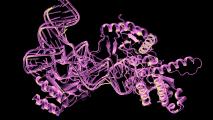Oxford University is currently enrolling up to 10,260 people for a combined Phase 2 and 3 coronavirus vaccine trial in the UK.
The researchers had already inoculated more than 1,000 healthy volunteers, between the ages of 18 and 55, in its Phase 1 trial.
For the Phase 2/3 trial, they’re expanding testing to include people older than 70 and children between the ages of 5 and 12 — the key to ensuring we end up with a vaccine that can protect people of all ages from COVID-19.
Oxford’s Coronavirus Vaccine Trial
Oxford created its vaccine, ChAdOx1, by adding genetic material from the coronavirus’s spike protein to a harmless cold virus.
In March, researchers behind a small study involving six rhesus macaque monkeys reported that the Oxford vaccine could protect the monkeys from contracting the disease, for at least 28 days, despite being directly exposed to the virus.
The animal study was followed by the launch of the Phase 1 human safety trial in April — Europe’s first coronavirus vaccine trial. While following up on those trial participants, the Oxford researchers will use this Phase 2 trial to see what sort of immune response the vaccine prompts in people of various age groups.
We may get enough data in a couple of months to see if the vaccine works.
Oxford University
This is key, because older and younger people tend to have weaker immune responses, which means that a vaccine that works well for healthy young adults might not protect the people who are most vulnerable to the illness.
The Phase 3 coronavirus vaccine trial, involving some of the same participants, will then focus on the vaccine’s ability to prevent someone from catching the coronavirus. Because this requires people to be exposed to the virus, the speed of its results will depend on the UK’s infection rate.
“If transmission remains high, we may get enough data in a couple of months to see if the vaccine works,” the Oxford researchers said in a statement. “But if transmission levels drop, this could take up to six months.”
If all goes perfectly, the researchers say they could have millions of doses of their coronavirus vaccine ready for people of all ages by September.
The COVID-19 Monkey Study
So far, eight coronavirus vaccines have reached the human trial stage, and the Oxford vaccine has been considered one of the most promising — making the launch of its latest coronavirus vaccine trial a major hopeful development in the battle against COVID-19.
However, expectations for the vaccine have been tempered by the May 13 publication of the March monkey study’s results on the preprint server bioRxiv.
The study suggests that while the Oxford vaccine prevented the six vaccinated monkeys from contracting pneumonia, the coronavirus’s genetic material was still detected in their nose samples.
It’s possible that these tests were only picking up fragments of the virus, left over from when it was sprayed up their noses, or dead viruses shredded by their immune system. But it could also mean that the monkeys still got infected with the virus but simply had milder cases.
“If this represents infectious virus and a similar thing occurs in humans, then vaccinated people can still be infected, shed large amounts of virus which could potentially spread to others in the community,” Jonathan Ball, a molecular virologist from University of Nottingham, told the Independent.
A vaccine that prevents a serious illness would still be very valuable, but it might not do anything to stop the spread of the virus.
Still, the nature of the monkey trial — the monkeys received only a single dose of the vaccine and then were exposed to a massive amount of the virus, far higher than humans are likely to encounter — has left others unfazed.
“None of the vaccines in development will work with one shot (that’s just not how vaccines work),” immunologist Florian Krammer wrote on Twitter. “This was after one shot. The lung was protected. Two shots might be pretty solid.”
We’d love to hear from you! If you have a comment about this article or if you have a tip for a future Freethink story, please email us at [email protected].






